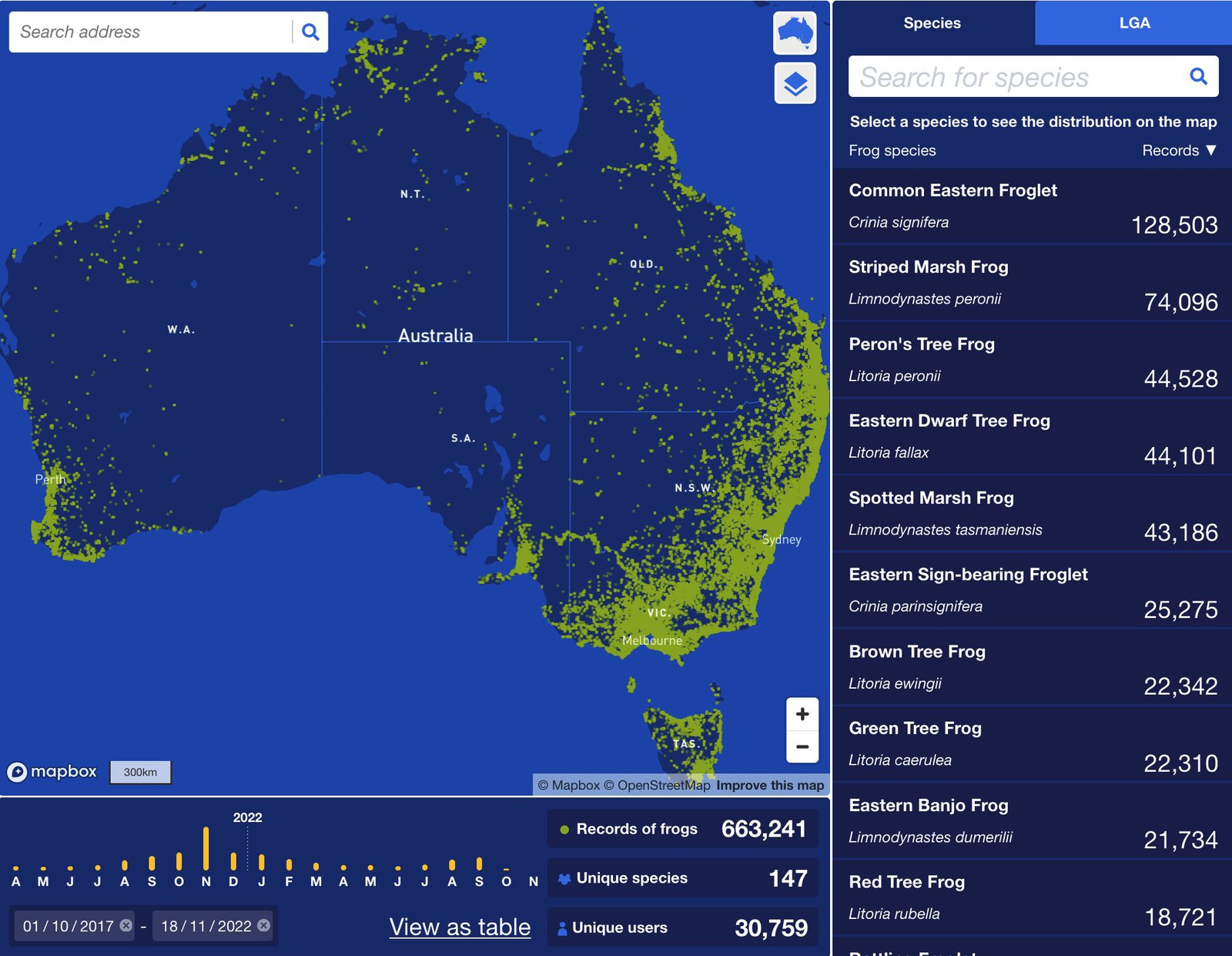FrogID, Atlassian Foundation and Engage4Good
The Australian Museum collaborated with Atlassian Foundation through the Engage4Good program, a program designed to connect subject matter experts with a real-world challenge.
This project supported two Atlassian team members to volunteer their time and skills to help us enhance our much-loved FrogID project to ensure the best outcome for frog research and conservation over the long term. In our case, it was a matter of matching our unique acoustic dataset with the identification capabilities of Artificial Intelligence and Machine Learning technology, through through Atlassian employee expertise.

© Australian Museum
About FrogID
FrogID is a national citizen science project run by the Australian Museum. The project enables anyone with a smartphone to record frog calls as a measurement of frog distribution and ecosystem health across the country. There are 246 native frog species in Australia, many of which are under threat from habitat loss, disease, pollution and climate change. Frogs are integral part of healthy ecosystems in Australia, yet we lack so much information about them. Every FrogID recording contributes to a national database of frogs that helps fill knowledge gaps that helps better conserve our frogs.
Since 2017, over 40,000 FrogID participants have contributed to the national FrogID project and over 500,000 recordings have been submitted. The accuracy of frog recording identification is key to the integrity of FrogID, as it is the only continental-scale citizen science project in the world with expert review and validation for frog call identification. Maintaining scientific accuracy is critical for our project to continue to inform frog research and conservation.
This collective information directly aids frog conservation, environmental monitoring and helps inform biodiversity and conservation management decisions. Through thousands of audio submissions from citizen scientists across the country, FrogID has rapidly built a unique, continental-scale database of frog records like no other in the world.
The problem
Currently Australian Museum staff manually identify FrogID recordings. After five years, the FrogID project has been so successful, with submissions continuing to grow, that we can't always keep up with speedily validating submissions. The project needs deep technical expertise to help take FrogID audio identification from a ‘people-powered’ problem to an ‘in-product’ solution.
The FrogID team had previously explored how to build an algorithm to automatically identify frog species in submitted recordings. But this work is for data science problem-solving experts, as frog species vary in their call traits and many FrogID recordings have multiple frog species calling at the same time with varying background noise, making identification challenging.
Matching frog calls in FrogID recordings is also not as straight forward as a Shazam for matching music recordings. We would need to isolate call patterns from each other to ensure that all species present in a call are identified. This is where we wanted to leverage Atlassian Foundation’s expertise to work towards an automated solution.
The automation of frog species identification would benefit FrogID in many ways, including:
- Reduce operational costs.
- Increase capacity to receive submissions.
- Provide a larger scientific dataset to inform biodiversity and conservation management.
- Increase user retention, with users seeing their FrogID contribution immediately.
- Provide a long-term solution for frog monitoring, new frog species discovery and acoustic monitoring for biodiversity more broadly.

© Australian Museum
Audio fingerprinting
Each frog has it's own unique call, much like humans have unique fingerprints. Their calls vary in duration, frequency and intensity. Similarly, other common sounds we record like humans, birds, insects or running water and wind also have their own distinguishable pattern.
Spectrogram of frog species sounds

Spectrograms of frog species calls.
Image: Geoff Sims© Geoff Sims
Spectrogram of other sounds

Spectrograms of other non-frog calls
Image: Geoff Sims© Geoff Sims
Engage4Good Program
The FrogID project was selected for the Atlassian Foundation Engage4Good program mid-March 2022, allowing Geoff Sims and Michael Cooper from the Atlassian team to come on board the FrogID project and volunteer their worktime towards solving how to automatically identify FrogID recordings.
Collaborating with experts in Machine Learning and Artificial Intelligence helped re-frame problems and gave meaningful next steps for the Australian Museum to action. The program has allowed the Atlassian Foundation team to apply tangible work with direct outcomes in frog conservation and land management. More rapid acoustic identification through advances in Machine Learning will improve our understanding of how species are responding to a changing planet, and not just frogs, but other animal groups monitored acoustically. The Australian Museum FrogID team are actively working to integrate aspects of the work completed during the Engage4Good program. The aim of this activity is to reduce strain on our frog call validators and also help reduce project costs. This will be tested in the live FrogID environment to evaluate the real-world application of audio triaging of submitted audio recordings. Watch this space for more!
Engage4Good has been transformative for FrogID and is a true example of how strategic collaboration can drive mutual impact. For the Museum, it has sharpened our understanding of what’s needed to apply this technology to masses of acoustic frog data provided by our passionate citizen scientists. For Atlassian, it has offered experts the opportunity to apply their skills in a different environment, contributing directly to addressing the real-life challenges facing biodiversity conservation today. None of this would be possible without the support of Atlassian Foundation.
Please keep those FrogID submissions coming to help us grow our powerful acoustic dataset.













